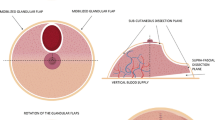Abstract
A horseshoe perianal skin melanoma was treated by cutaneous advancement flap (Y-V shaped) and the outcome was investigated over a long-term follow-up. Objects of investigation were the history taking, the preoperative work-up, the adopted surgical procedure, and the histological and immune-histochemical findings concerning additional lesions found during the follow-up. The follow-up lasted 140 months. In this patient, a previous breast cancer was diagnosed and treated. Local diffusion of soft tissue, nodes, and anal sphincter infiltration or distant metastasis were not shown preoperatively. A wide excision with an advancement flap Y-V was carried out. Histological findings showed a level II of Clark with Breslow 0.65 mm. No local or distant recurrences were found by follow-up. Sixty months later, two pigmented lesions (0.3 0.2 mm) were detected and removed. Histologically, a hyperpigmentation of the basal layer of epidermis and immunostaining with Melan-A and CD 117 confirmed the absence of any significant melanocytic proliferation. Ninety months after the first procedure, a new small cell carcinoma of the right lung was detected leading the patient to death after 140 months. The findings of this report raise issues related to plastic and reconstructive modality but also to oncological outcome. We were also able to recognize a possible compromised immune deficiency over a considerable life span. However, the occurrence of melanoma did not affect the unfavorable outcome, which was caused by other cancers.
Level of Evidence: Level V, prognostic study




Similar content being viewed by others
References
Iddings DM, Fleisig AJ, Chen SL, Faries MB, Morton DL (2010) Practice patterns and outcomes for anorectal melanoma in United States. Is more extensive surgical resection beneficial in all patients? Ann Surg Oncol 17(1):40–44
Wietfeldt ED, Thiele J (2009) Malignancies of the anal margin and perianal skin. Clin Colon Rectal Surg 22(02):127–136
Micu E, Juzeniene A, Moa J (2011) Comparison of the time and latitude trends of melanoma incidence in anorectal region and perianal skin with those of cutaneous malignant melanoma in Norway. J Eur Acad Dermatol Venereol 25:1444–1449
Nagano T, Kotani S, Omori M, Kosaka H, Ogawa M (2017) Pigmented extramammary Paget’s disease: pitfalls of diagnosis. J Dermatol 44:1323–1325
Ishida M, Iwai M, Kagotani A (2014) Pigmented anal squamous intraepithelial neoplasia: a case report and review of literature. Int J Clin Exp Pathol 7(6):3456–3459. eCollection 2014
Bourlond A (1994) Pigmented epidermotropic metastasis of a breast carcinoma. Dermatology 189(Suppl 2):46–49
Weyandt GH, Eggert AO, Houf M, Raulf F, Bröcker EB, Becker JC (2003) Anorectal melanoma: surgical management guidelines according to tumour thickness. Br J Cancer 89(11):2019–2022
Hassan I, Horgan AF, Nivatvongs S (2001) V-Y island flaps for repair of large perianal defects. Am J Surg 181:363–365
Shishido E, Kadono S, Manaka I, Kawashima M, Imokawa G (2001) The mechanism of epidermal hyperpigmentation in dermatofibroma is associated with stem cell factor and hepatocyte growth factor expression. J Invest Dermatol 117:627–633
Rogers T, Pulitzer M, Marino ML, Marghoob AA, Zivanovic O, Marchetti MA (2016) Early diagnosis of genital mucosal melanoma: how good are our dermoscopic criteria? Dermatol Pract Concept 6(4):43–46
Author information
Authors and Affiliations
Corresponding author
Ethics declarations
Conflict of interest
Corrado Rosario Asteria, Angelo Cassisa, Anna Asteria, and Andrea Zanca declare that they have no conflict of interest.
Funding
None
Ethical approval
All procedures performed in studies involving human participants were in accordance with the ethical standards of the institutional and/or national research committee and with the 1964 Helsinki declaration and its later amendments or comparable ethical standards. However, for this tye of retrospective study, formal consent is not required.
Patient consent
Consent for the publication of this case and any additional related information was taken from the next of kin of the patient involved in the study.
Rights and permissions
About this article
Cite this article
Asteria, C.R., Cassisa, A., Asteria, A. et al. The treatment of perianal skin horseshoe melanoma by advancement flap (Y-V shaped) and the assessment of outcome over a long-term follow-up. Eur J Plast Surg 41, 479–482 (2018). https://doi.org/10.1007/s00238-018-1397-0
Received:
Accepted:
Published:
Issue Date:
DOI: https://doi.org/10.1007/s00238-018-1397-0



